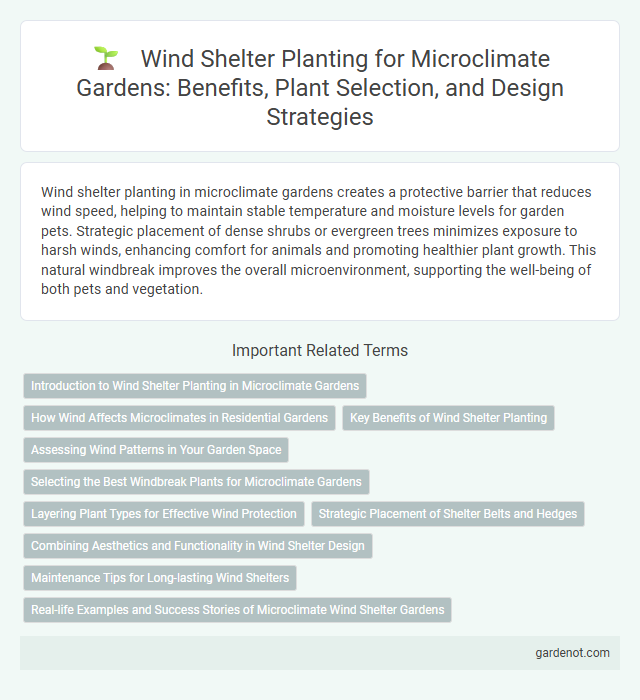Wind shelter planting in microclimate gardens creates a protective barrier that reduces wind speed, helping to maintain stable temperature and moisture levels for garden pets. Strategic placement of dense shrubs or evergreen trees minimizes exposure to harsh winds, enhancing comfort for animals and promoting healthier plant growth. This natural windbreak improves the overall microenvironment, supporting the well-being of both pets and vegetation.
Introduction to Wind Shelter Planting in Microclimate Gardens
Wind shelter planting in microclimate gardens involves strategically placing trees, shrubs, and hedges to reduce wind speed and create a more stable environment for plants. Effective windbreaks minimize soil erosion, protect delicate flora, and enhance temperature regulation, supporting diverse plant growth. Selecting species with dense foliage and varying heights optimizes wind reduction and microclimate stability.
How Wind Affects Microclimates in Residential Gardens
Wind significantly influences microclimates in residential gardens by altering temperature, humidity, and soil moisture levels. Strategic wind shelter planting with dense shrubs or trees reduces wind speed, minimizing heat loss and preventing soil erosion. These planted barriers create calmer microclimates that support healthier plant growth and improve garden comfort.
Key Benefits of Wind Shelter Planting
Wind shelter planting significantly reduces wind speed, protecting delicate plants from physical damage and moisture loss, which enhances overall garden health. It improves microclimate stability by moderating temperature fluctuations and increasing humidity levels, creating a more favorable environment for diverse plant species. This practice also conserves soil moisture and prevents erosion, leading to increased crop yield and sustainable garden growth.
Assessing Wind Patterns in Your Garden Space
Evaluating wind patterns in your garden involves observing prevailing wind directions, speed, and seasonal variations to identify areas vulnerable to strong gusts. Use tools such as anemometers or simple wind vanes to gather data over time, mapping zones that require protective planting. This assessment guides strategic placement of wind shelter plants, enhancing garden microclimate by reducing wind stress on sensitive vegetation.
Selecting the Best Windbreak Plants for Microclimate Gardens
Selecting the best windbreak plants for microclimate gardens involves choosing species that are hardy, fast-growing, and capable of creating dense foliage to reduce wind speed effectively. Evergreens such as arborvitae, holly, and juniper provide year-round protection, while deciduous shrubs like dogwood and viburnum offer seasonal shelter and contribute to biodiversity. Proper spacing and layering of these plants enhance their efficiency in creating a stable, sheltered environment that improves garden microclimates.
Layering Plant Types for Effective Wind Protection
Layering plant types in wind shelter planting creates a robust microclimate by combining tall trees, medium shrubs, and low groundcovers, effectively reducing wind speed and protecting garden spaces. Incorporating evergreens provides year-round windbreak benefits, while deciduous plants enhance seasonal airflow control. Strategic placement of diverse layers maximizes wind deflection, minimizes soil erosion, and improves overall plant health in microclimate gardens.
Strategic Placement of Shelter Belts and Hedges
Strategic placement of shelter belts and hedges in microclimate gardens significantly reduces wind speed, protecting plants from damage and moisture loss. Selecting dense, multi-layered species with varying heights creates effective barriers that enhance air circulation and humidity retention. Proper orientation and spacing optimize windbreak efficiency, promoting a stable, favorable microenvironment for garden growth.
Combining Aesthetics and Functionality in Wind Shelter Design
Wind shelter planting integrates dense shrubs, tall grasses, and strategically placed trees to create both visual appeal and effective wind attenuation in microclimate gardens. Selecting species with varying heights and textures enhances aesthetic diversity while optimizing airflow reduction and microclimate stabilization. This synergy of design and function promotes a comfortable, protected environment conducive to plant health and outdoor enjoyment.
Maintenance Tips for Long-lasting Wind Shelters
Regular pruning and timely removal of dead or damaged branches enhance the density and effectiveness of wind shelter plants, ensuring continuous protection. Applying mulch around the base retains soil moisture and suppresses weeds, promoting healthy root development for long-lasting growth. Inspections for pest infestations and diseases allow early intervention, preserving plant vigor and the structural integrity of the wind shelter.
Real-life Examples and Success Stories of Microclimate Wind Shelter Gardens
Wind shelter planting in microclimate gardens significantly reduces wind speed, promoting healthier plant growth and higher yields, as demonstrated by the agroforestry systems in Kenya's Machakos region where strategic tree species like Grevillea robusta create effective windbreaks. In coastal California, farmers have implemented wind shelter belts using native shrub species such as Ceanothus and Arctostaphylos, resulting in increased moisture retention and reduced soil erosion in vineyards. Research from the Netherlands highlights urban community gardens utilizing tall ornamental grasses and hedges to form wind barriers, enhancing crop resilience and extending growing seasons.
Wind shelter planting Infographic

 gardenot.com
gardenot.com